Saffron's extraordinary price tag isn't arbitrary—it represents one of nature's most labor-intensive agricultural processes. Each delicate Crocus sativus flower produces only three stigmas, which must be hand-picked at dawn before the flowers fully open. This meticulous harvesting process, combined with the sheer volume of flowers required, creates the perfect storm of scarcity that drives saffron's premium pricing.
Why Saffron Commands Such High Prices
The fundamental reason behind saffron's expense lies in its production process. Unlike machine-harvested spices, saffron requires entirely manual labor at every stage:
- Flower harvesting: Must occur at first light when flowers are still closed
- Stigma extraction: Three delicate red threads per flower must be carefully removed by hand
- Drying process: Requires precise temperature control to preserve flavor compounds
- Quality sorting: Final product is graded by color intensity, length, and aroma
To produce just one pound (454 grams) of dried saffron, farmers must harvest between 75,000 and 250,000 crocus flowers. This translates to approximately 300-400 hours of meticulous hand labor per pound. When you consider that a single worker can typically harvest only 0.1-0.2 pounds per day, the labor economics become immediately apparent.
| Saffron Grade | Price Per Gram | Price Per Ounce | Price Per Pound |
|---|---|---|---|
| Premium (Negin/Coupé) | $12-$15 | $340-$425 | $5,400-$6,800 |
| Superior (Sargol) | $8-$12 | $225-$340 | $3,600-$5,400 |
| Regular (Pushal) | $5-$8 | $140-$225 | $2,200-$3,600 |
| Lower Grade (Bunch) | $3-$5 | $85-$140 | $1,350-$2,200 |
Factors Influencing Saffron Pricing
Several critical factors determine saffron's market value, creating significant price variations even within the same harvest:
Quality Grading System
Saffron is graded based on ISO 3632 standards that measure crocin (color), picrocrocin (taste), and safranal (aroma) content. Higher grades contain more of these compounds:
- Negin/Coupé: Long, deep red threads with highest coloring strength (200+ ISO)
- Sargol: Top-quality cut threads, slightly lower than Negin (190-200 ISO)
- Pushal: Includes some yellow styles, moderate quality (150-190 ISO)
- Bunch: Whole threads with yellow styles attached, lowest quality (80-150 ISO)
Geographical Origin
While Iran produces 90% of the world's saffron, regional differences affect pricing:
- Persian (Iranian): Most common, offers best value at high quality
- Kashmiri: Rare, more floral notes, commands 20-30% premium
- Spanish: Often blends, marketed as premium despite lower quality
- Italian: Small production, high-end market positioning

Understanding Saffron Measurements and Value
When evaluating saffron prices, understanding proper measurements is crucial. Many retailers use confusing metrics to make prices appear lower than they actually are:
- Per gram pricing: The most reliable metric for comparison
- Volume vs. weight: Be wary of "per teaspoon" or "per packet" pricing
- Adulteration risks: Extremely cheap saffron often contains fillers
A single gram of premium saffron contains approximately 400-450 threads and should yield enough flavor and color for 4-6 servings of paella or risotto. When calculating value, consider that a $10 packet containing 0.5 grams provides only 8-12 servings, making each serving cost approximately $0.83-$1.25—comparable to other specialty ingredients in fine cooking.
How Saffron Compares to Other Premium Spices
To put saffron's price in perspective, consider these comparisons with other high-value spices:
| Spice | Price Per Pound | Price Per Gram | Production Notes |
|---|---|---|---|
| Saffron | $5,000-$15,000 | $11-$33 | 75,000-250,000 flowers per pound |
| Vanilla Beans | $300-$600 | $0.66-$1.32 | Hand-pollinated orchids, 9-month curing |
| Cardamom | $30-$60 | $0.07-$0.13 | Mechanically harvested, higher yield |
| Sandalwood | $1,000-$10,000 | $2.20-$22.00 | Tree heartwood, 30+ year maturity |
Avoiding Overpayment: Smart Saffron Purchasing Tips
Understanding saffron pricing helps avoid common pitfalls that lead consumers to overpay:
- Check the ISO rating: Legitimate sellers provide ISO 3632 certification numbers
- Examine thread appearance: Premium saffron has deep red color without yellow styles
- Perform the water test: Real saffron slowly releases golden color in warm water
- Beware of suspiciously low prices: Anything below $5/gram likely contains fillers
- Consider quantity needs: Small quantities (0.5-1g) often provide best value for home use
When evaluating potential purchases, remember that genuine saffron should have a distinctive honey-like aroma with hay notes—not a musty or chemical smell. The threads should feel dry but not brittle, and maintain their deep red color without excessive breakage.

Market Trends Affecting Current Saffron Prices
Several factors have influenced saffron pricing in recent years:
- Climate challenges: Drought conditions in Iran have reduced recent harvests by 15-20%
- Increased global demand: Rising popularity in Western cuisine has doubled demand since 2015
- Currency fluctuations: Iranian rial volatility affects export pricing
- Quality standardization: ISO certification has created clearer pricing tiers
- Counterfeit concerns: Increased testing has reduced fraudulent products in premium markets
Looking forward, saffron prices are expected to remain stable or increase slightly as climate challenges continue and global demand grows. However, improved farming techniques in traditional growing regions may help moderate price increases in the long term.
Conclusion: Understanding Saffron's True Value
Saffron's price reflects not just its rarity, but the centuries-old craftsmanship required to produce it. When properly stored and used, a small amount delivers extraordinary flavor and color that transforms ordinary dishes into culinary masterpieces. Understanding the factors behind saffron pricing empowers consumers to make informed decisions about quality versus cost, ensuring they receive genuine value for this extraordinary spice.
Why is saffron more expensive than gold by weight?
Saffron's price exceeds gold by weight because of its extremely labor-intensive harvesting process. It takes 75,000-250,000 crocus flowers to produce just one pound of saffron, requiring 300-400 hours of meticulous hand labor. Gold's value comes from geological rarity, while saffron's value stems from human labor requirements combined with biological constraints of the crocus flower.
How much saffron should I expect to pay for genuine premium quality?
For genuine premium saffron (Negin grade), expect to pay $10-$15 per gram, $280-$425 per ounce, or $5,000-$10,000 per kilogram. Prices below $5 per gram typically indicate lower quality or potentially adulterated product. Reputable sellers provide ISO 3632 certification numbers to verify quality grade.
What's the difference between saffron price per gram versus per ounce?
Saffron pricing is most accurately compared per gram since ounce measurements can be confusing (1 ounce = 28.35 grams). High-quality saffron costs $5-$15 per gram, which translates to $140-$425 per ounce. Many retailers use ounce pricing to make prices appear lower, but gram pricing provides the clearest value comparison between products.
How can I tell if saffron is priced too low to be genuine?
Saffron priced below $3-$5 per gram is likely adulterated or extremely low quality. Genuine saffron requires 150-200 hand-picked flowers per thread, making extremely low prices economically impossible. Warning signs include unusually dark threads (may be dyed), lack of floral aroma, or prices that seem too good to be true. Real saffron slowly releases golden color in warm water rather than immediate intense coloring.
Does expensive saffron actually taste better than cheaper options?
Yes, higher-priced saffron typically delivers significantly better flavor, color, and aroma. Premium grades (Negin/Sargol) contain higher concentrations of crocin, picrocrocin, and safranal—the compounds responsible for saffron's distinctive properties. Lower-priced options often include yellow styles that add weight but no flavor, or may be blended with fillers. The difference is noticeable even in small amounts used in cooking.











 浙公网安备
33010002000092号
浙公网安备
33010002000092号 浙B2-20120091-4
浙B2-20120091-4